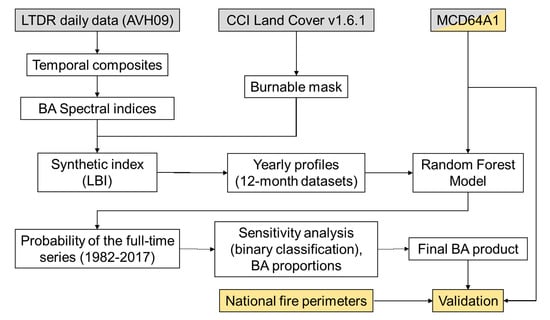Global Detection of Long-Term (1982–2017) Burned Area with AVHRR-LTDR Data
Abstract
1. Introduction
2. Methods
2.1. General Workflow
2.2. Land Long Term Data Record Dataset
2.3. Composites
2.4. Input Bands
2.5. LTDR Burned Area Index
2.6. Random Forest Model
2.7. Estimation of Burned Proportions
2.8. Number of Observations
2.9. Validation
3. Results
3.1. Spatial Patterns
3.2. Temporal Trends
3.3. Validation Results
4. Discussion
5. Conclusions
Author Contributions
Funding
Acknowledgments
Conflicts of Interest
References
- Ciais, P.; Sabine, C.; Bala, G.; Bopp, L.; Brovkin, V.; Canadell, J.; Chhabra, A.; DeFries, R.; Galloway, J.; Heimann, M.; et al. Carbon and other biogeochemical cycles. In Climate Change 2013: The Physical Science Basis. Contribution of Working Group I to the Fifth Assessment Report of the Intergovernmental Panel on Climate Change; Stocker, T.F., Qin, D., Plattner, G.-K., Tignor, M., Allen, S.K., Boschung, J., Nauels, A., Xia, Y., Bex, V., Midgley, P.M., Eds.; Cambridge University Press: Cambridge, UK, 2014; pp. 465–570. [Google Scholar]
- Bond, W.J.; Woodward, F.I.; Midgley, G.F. The global distribution of ecosystems in a world without fire. New Phytol. 2005, 165, 525–538. [Google Scholar] [CrossRef] [PubMed]
- Urbanski, S.P.; Hao, W.M.; Baker, S. Chemical composition of wildland fire emissions. Dev. Environ. Sci. 2008, 8, 79–107. [Google Scholar]
- GCOS. Systematic Observation Requirements for Satellite-Based Products for Climate, 2011 Update; World Meteorological Organization: Geneva, Switzerland, 2011. [Google Scholar]
- Granier, C.; Bessagnet, B.; Bond, T.; D’Angiola, A.; van Der Gon, H.D.; Frost, G.J.; Heil, A.; Kaiser, J.W.; Kinne, S.; Klimont, Z.; et al. Evolution of anthropogenic and biomass burning emissions of air pollutants at global and regional scales during the 1980–2010 period. Clim. Chang. 2011, 109, 163–190. [Google Scholar] [CrossRef]
- Ward, D.; Kloster, S.; Mahowald, N.; Rogers, B.; Randerson, J.; Hess, P. The changing radiative forcing of fires: Global model estimates for past, present and future. Atmos. Chem. Phys. 2012, 12, 10857–10886. [Google Scholar] [CrossRef]
- Hantson, S.; Arneth, A.; Harrison, S.P.; Kelley, D.I.; Prentice, I.C.; Rabin, S.S.; Archibald, S.; Mouillot, F.; Arnold, S.R.; Artaxo, P.; et al. The status and challenge of global fire modelling. Biogeosciences 2016, 13, 3359–3375. [Google Scholar] [CrossRef]
- Mouillot, F.; Field, C.B. Fire history and the global carbon budget: A 1 degrees × 1 degrees fire history reconstruction for the 20th century. Glob. Chang. Biol. 2005, 11, 398–420. [Google Scholar] [CrossRef]
- Power, M.J.; Marlon, J.R.; Bartlein, P.J.; Harrison, S.P. Fire history and the global charcoal database: A new tool for hypothesis testing and data exploration. Palaeogeogr. Palaeoclimatol. Palaeoecol. 2010, 291, 52–59. [Google Scholar] [CrossRef]
- Mouillot, F.; Schultz, M.G.; Yue, C.; Cadule, P.; Tansey, K.; Ciais, P.; Chuvieco, E. Ten years of global burned area products from spaceborne remote sensing—A review: Analysis of user needs and recommendations for future developments. Int. J. Appl. Earth Obs. Geoinf. 2014, 26, 64–79. [Google Scholar] [CrossRef]
- Grégoire, J.M.; Tansey, K.; Silva, J.M.N. The gba2000 initiative: Developing a global burned area database from spot-vegetation imagery. Int. J. Remote Sens. 2003, 24, 1369–1376. [Google Scholar] [CrossRef]
- Tansey, K.; Grégoire, J.M.; Defourny, P.; Leigh, R.; Peckel, J.F.; Bogaert, E.V.; Bartholome, J.E. A new, global, multi-annual (2000–2007) burnt area product at 1 km resolution. Geophys. Res. Lett. 2008, 35, L01401. [Google Scholar] [CrossRef]
- Copernicus Programme. Available online: https://land.copernicus.eu/ (accessed on 1 September 2019).
- Roy, D.P.; Boschetti, L.; Justice, C.O. The collection 5 modis burned area product—Global evaluation by comparison with the modis active fire product. Remote Sens. Environ. 2008, 112, 3690–3707. [Google Scholar] [CrossRef]
- Giglio, L.; Boschetti, L.; Roy, D.P.; Humber, M.L.; Justice, C.O. The collection 6 modis burned area mapping algorithm and product. Remote Sens. Environ. 2018, 217, 72–85. [Google Scholar] [CrossRef]
- Van Der Werf, G.R.; Randerson, J.T.; Giglio, L.; Van Leeuwen, T.T.; Chen, Y.; Rogers, B.M.; Mu, M.; Van Marle, M.J.; Morton, D.C.; Collatz, G.J.; et al. Global fire emissions estimates during 1997–2016. Earth Syst. Sci. Data 2017, 9, 697–720. [Google Scholar] [CrossRef]
- Chuvieco, E.; Lizundia-Loiola, J.; Pettinari, M.L.; Ramo, R.; Padilla, M.; Tansey, K.; Mouillot, F.; Laurent, P.; Storm, T.; Heil, A. Generation and analysis of a new global burned area product based on modis 250 m reflectance bands and thermal anomalies. Earth Syst. Sci. Data 2018, 10, 2015–2031. [Google Scholar] [CrossRef]
- Chuvieco, E.; Englefield, P.; Trishchenko, A.P.; Luo, Y. Generation of long time series of burn area maps of the boreal forest from noaa–avhrr composite data. Remote Sens. Environ. 2008, 112, 2381–2396. [Google Scholar] [CrossRef]
- Kucêra, J.; Yasuoka, Y.; Dye, D.G. Creating a forest fire database for the far east of asia using noaa/avhrr observation. Int. J. Remote Sens. 2005, 26, 2423–2439. [Google Scholar] [CrossRef]
- Sukhinin, A.I.; French, N.H.F.; Kasischke, E.S.; Hewson, J.H.; Soja, A.J.; Csiszar, I.A.; Hyer, E.J.; Loboda, T.; Conrad, S.G.; Romasko, V.I.; et al. Avhrr-based mapping of fires in Russia: New products for fire management and carbon cycle studies. Remote Sens. Environ. 2004, 93, 546–564. [Google Scholar] [CrossRef]
- Barbosa, P.M.; Grégoire, J.M.; Pereira, J.M.C. An algorithm for extracting burned areas from time series of avhrr gac data applied at a continental scale. Remote Sens. Environ. 1999, 69, 253–263. [Google Scholar] [CrossRef]
- Moreno Ruiz, J.A.; Riano, D.; Arbelo, M.; French, N.H.; Ustin, S.L.; Whiting, M.L. Burned area mapping time series in canada (1984–1999) from noaa-avhrr ltdr: A comparison with other remote sensing products and fire perimeters. Remote Sens. Environ. 2012, 117, 407–414. [Google Scholar] [CrossRef]
- García-Lázaro, J.; Moreno-Ruiz, J.; Riaño, D.; Arbelo, M. Estimation of burned area in the northeastern siberian boreal forest from a long-term data record (ltdr) 1982–2015 time series. Remote Sens. 2018, 10, 940. [Google Scholar] [CrossRef]
- Riaño, D.; Ruiz, J.A.M.; Isidoro, D.; Ustin, S.L. Global spatial patterns and temporal trends of burned area between 1981 and 2000 using noaa-nasa pathfinder. Glob. Chang. Biol. 2007, 13, 40–50. [Google Scholar] [CrossRef]
- European Space Agency and Fire_cci Project Team. Available online: https://www.esa-fire-cci.org/ (accessed on 1 September 2019).
- Pedelty, J.; Devadiga, S.; Masuoka, E.; Brown, M.; Pinzon, J.; Tucker, C.; Vermote, E.; Prince, S.; Nagol, J.; Justice, C.; et al. Generating a long-term land data record from the avhrr and modis instruments. In Proceedings of the 2007 IEEE International Geoscience and Remote Sensing Symposium, Barcelona, Spain, 23–28 July 2007; pp. 1021–1025. [Google Scholar]
- ESA. Land Cover cci: Algorithm Theoretical Basis Document Version 2; Land_Cover_CCI_ATBDv2_2.3; ESA: Louvain, Belgium, 2013; 191p, Available online: https://www.esa-landcover-cci.org/?q=webfm_send/75 (accessed on 02 September 2019).
- Padilla, M.; Stehman, S.V.; Hantson, S.; Oliva, P.; Alonso-Canas, I.; Bradley, A.; Tansey, K.; Mota, B.; Pereira, J.M.; Chuvieco, E. Comparing the accuracies of remote sensing global burned area products using stratified random sampling and estimation. Remote Sens. Environ 2015, 160, 114–121. [Google Scholar] [CrossRef]
- Padilla, M.; Wheeler, J.; Tansey, K. Esa Climate Change Initiative—Fire_cci. D4.1.1 Product Validation Report (pvr). Available online: http://www.esa-fire-cci.org/documents (accessed on 2 September 2019).
- Myneni, R.B.; Keeling, C.; Tucker, C.J.; Asrar, G.; Nemani, R.R. Increased plant growth in the northern high latitudes from 1981 to 1991. Nature 1997, 386, 698. [Google Scholar] [CrossRef]
- Horion, S.; Fensholt, R.; Tagesson, T.; Ehammer, A. Using earth observation-based dry season ndvi trends for assessment of changes in tree cover in the sahel. Int. J. Remote Sen. 2014, 35, 2493–2515. [Google Scholar] [CrossRef]
- Trishchenko, A.P.; Fedosejevs, G.; Li, Z.; Cihlar, J. Trends and uncertainties in thermal calibration of avhrr radiometers onboard noaa-9 to noaa-16. J. Geophys. Res. Atmos. 2002, 107, ACL 17-11–ACL 17-13. [Google Scholar] [CrossRef]
- Tian, F.; Fensholt, R.; Verbesselt, J.; Grogan, K.; Horion, S.; Wang, Y. Evaluating temporal consistency of long-term global ndvi datasets for trend analysis. Remote Sens. Environ. 2015, 163, 326–340. [Google Scholar] [CrossRef]
- Chuvieco, E.; Ventura, G.; Martín, M.P.; Gomez, I. Assessment of multitemporal compositing techniques of modis and avhrr images for burned land mapping. Remote Sens. Environ. 2005, 94, 450–462. [Google Scholar] [CrossRef]
- Rouse, J.W.; Haas, R.W.; Schell, J.A.; Deering, D.H.; Harlan, J.C. Monitoring the Vernal Advancement and Retrogradation (Greenwave effect) of Natural Vegetation; NASA/GSFC: Greenbelt, MD, USA, 1974. [Google Scholar]
- Simon, M.; Plummer, S.; Fierens, F.; Hoelzemann, J.J.; Arino, O. Burnt area detection at global scale using atsr-2: The globscar products and their qualification. J. Geophys. Res. Atmos. 2004, 109, D14S02. [Google Scholar] [CrossRef]
- Pinty, B.; Verstraete, M.M. Gemi: A non-linear index to monitor global vegetation from satellites. Vegetatio 1992, 101, 15–20. [Google Scholar] [CrossRef]
- Martín, M.P.; Chuvieco, E. Cartografía de grandes incendios forestales en la península ibérica a partir de imágenes noaa-avhrr. Ser. Geográfica 1998, 7, 109–128. [Google Scholar]
- Huete, A.R. A soil-adjusted vegetation index (savi). Remote Sens. Environ. 1988, 25, 295–309. [Google Scholar] [CrossRef]
- Chuvieco, E.; Martín, M.P.; Palacios, A. Assessment of different spectral indices in the red-near-infrared spectral domain for burned land discrimination. Int. J. Remote Sens. 2002, 23, 5103–5110. [Google Scholar] [CrossRef]
- McGwire, K.C.; Minor, T.; Fenstermaker, L. Hyperspectral mixture modeling for quantifying sparse vegetation cover in arid environments. Remote Sens. Environ. 2000, 72, 360–374. [Google Scholar] [CrossRef]
- Barbosa, P.M.; Gregoire, J.-M.; Pereira, J.M.C. Detection of Burned Areas in Africa using A Multitemporal Multithreshold Analysis of NOAA AVHRR GAC Data. In Proceedings of the SPIE, Bellingham, WA, USA, 22–25 September 1997. [Google Scholar]
- Chuvieco, E.; Mouillot, F.; van der Werf, G.R.; San Miguel, J.; Tanasse, M.; Koutsias, N.; García, M.; Yebra, M.; Padilla, M.; Gitas, I.; et al. Historical background and current developments for mapping burned area from satellite earth observation. Remote Sens. Environ. 2019, 225, 45–64. [Google Scholar] [CrossRef]
- Giglio, L.; Randerson, J.T.; Werf, G.R. Analysis of daily, monthly, and annual burned area using the fourth generation global fire emissions database (gfed4). J. Geophys. Res. Biogeosci. 2013, 118, 317–328. [Google Scholar] [CrossRef]
- Rodriguez-Galiano, V.F.; Ghimire, B.; Rogan, J.; Chica-Olmo, M.; Rigol-Sanchez, J.P. An assessment of the effectiveness of a random forest classifier for land-cover classification. ISPRS J. Photogramm. Remote Sens. 2012, 67, 93–104. [Google Scholar] [CrossRef]
- Pelletier, C.; Valero, S.; Inglada, J.; Champion, N.; Dedieu, G. Assessing the robustness of random forests to map land cover with high resolution satellite image time series over large areas. Remote Sens. Environ. 2016, 187, 156–168. [Google Scholar] [CrossRef]
- Belgiu, M.; Drăguţ, L. Random forest in remote sensing: A review of applications and future directions. ISPRS J. Photogramm. Remote Sens. 2016, 114, 24–31. [Google Scholar] [CrossRef]
- Ramo, R.; García, M.; Rodríguez, D.; Chuvieco, E. A data mining approach for global burned area mapping. Int. J. Appl. Earth Obs. Geoinf. 2018, 73, 39–51. [Google Scholar] [CrossRef]
- Ramo, R.; Chuvieco, E. Developing a random forest algorithm for modis global burned area classification. Remote Sens. 2017, 9, 1193. [Google Scholar] [CrossRef]
- Long, T.; Zhang, Z.; He, G.; Jiao, W.; Tang, C.; Wu, B.; Zhang, X.; Wang, G.; Yin, R. 30 m resolution global annual burned area mapping based on landsat images and google earth engine. Remote Sens. 2019, 11, 489. [Google Scholar] [CrossRef]
- Dice, L.R. Measures of the amount of ecologic association between species. Ecology 1945, 26, 297–302. [Google Scholar] [CrossRef]
- Natural Resources Canada. Available online: cwfis.cfs.nrcan.gc.ca/ha/nfdb (accessed on 1 September 2019).
- State of California. Available online: frap.fire.ca.gov (accessed on 1 September 2019).
- North Australia & Rangelands Fire Information. Available online: www.firenorth.org.au/nafi2 (accessed on 1 September 2019).
- Alonso-Canas, I.; Chuvieco, E. Global burned area mapping from envisat-meris and modis active fire data. Remote Sens. Environ. 2015, 163, 140–152. [Google Scholar] [CrossRef]
- Dillon, G.K.; Holden, Z.A.; Morgan, P.; Crimmins, M.A.; Heyerdahl, E.K.; Luce, C.H. Both topography and climate affected forest and woodland burn severity in two regions of the western us, 1984 to 2006. Ecosphere 2011, 2, 1–33. [Google Scholar] [CrossRef]
- European Space Agency and Fire_cci Project Team. Available online: https://geogra.uah.es/fire_cci/ltdr.php (accessed on 1 September 2019).
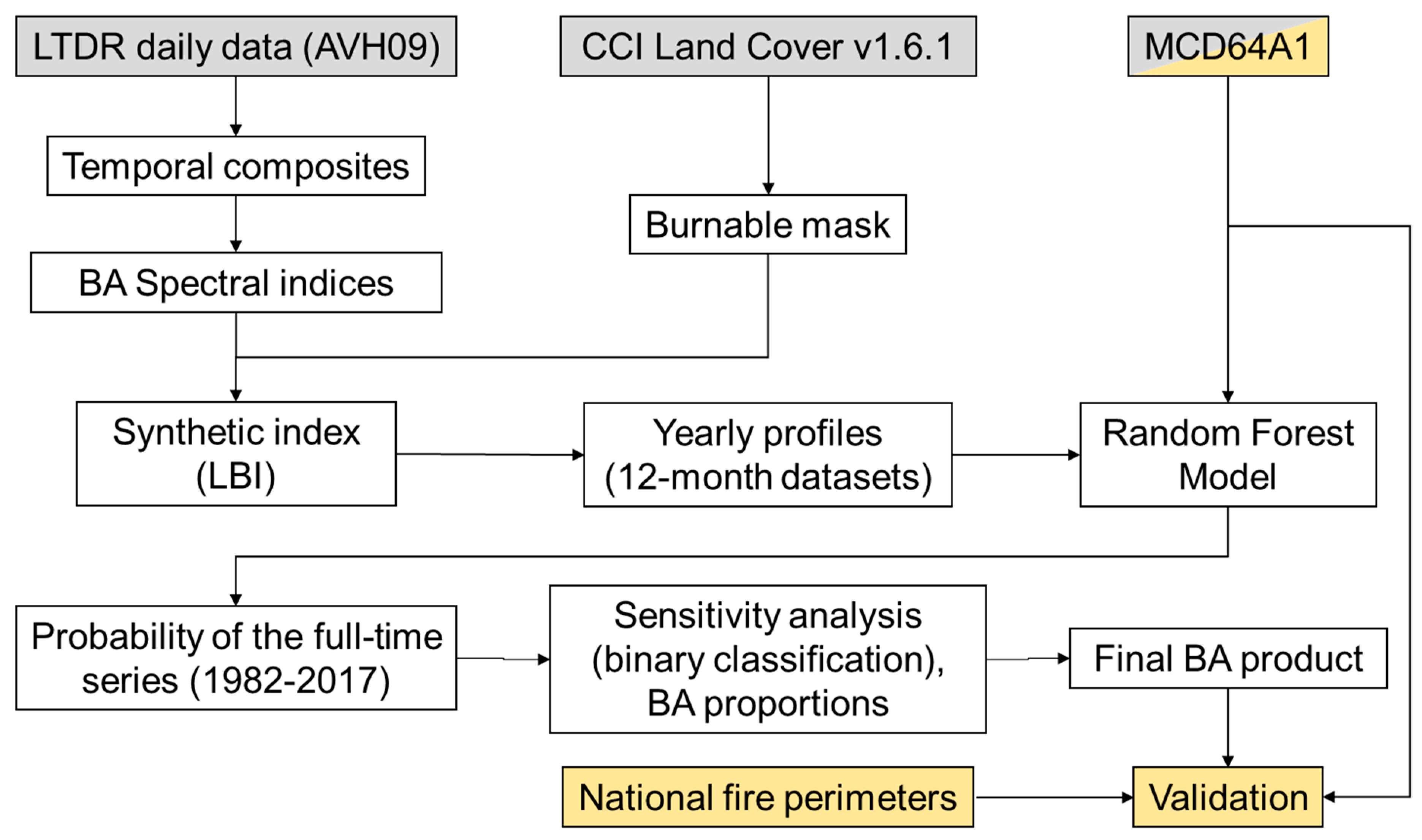

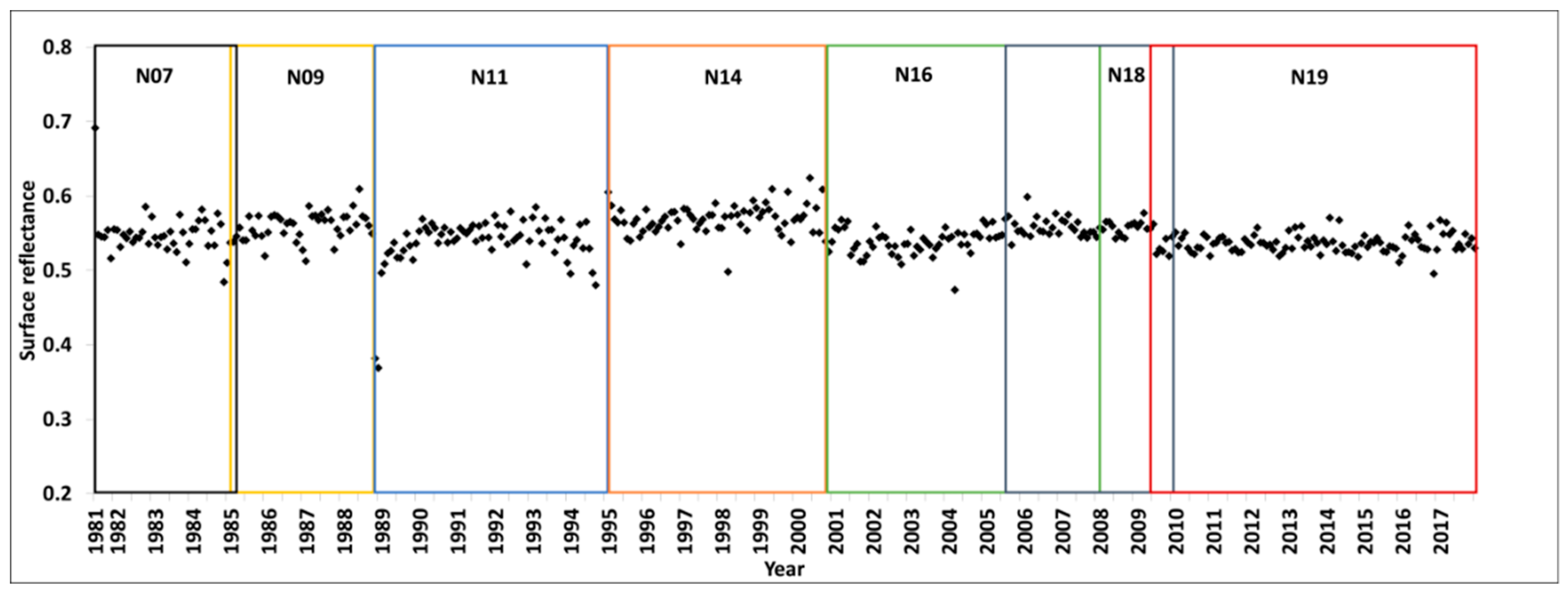



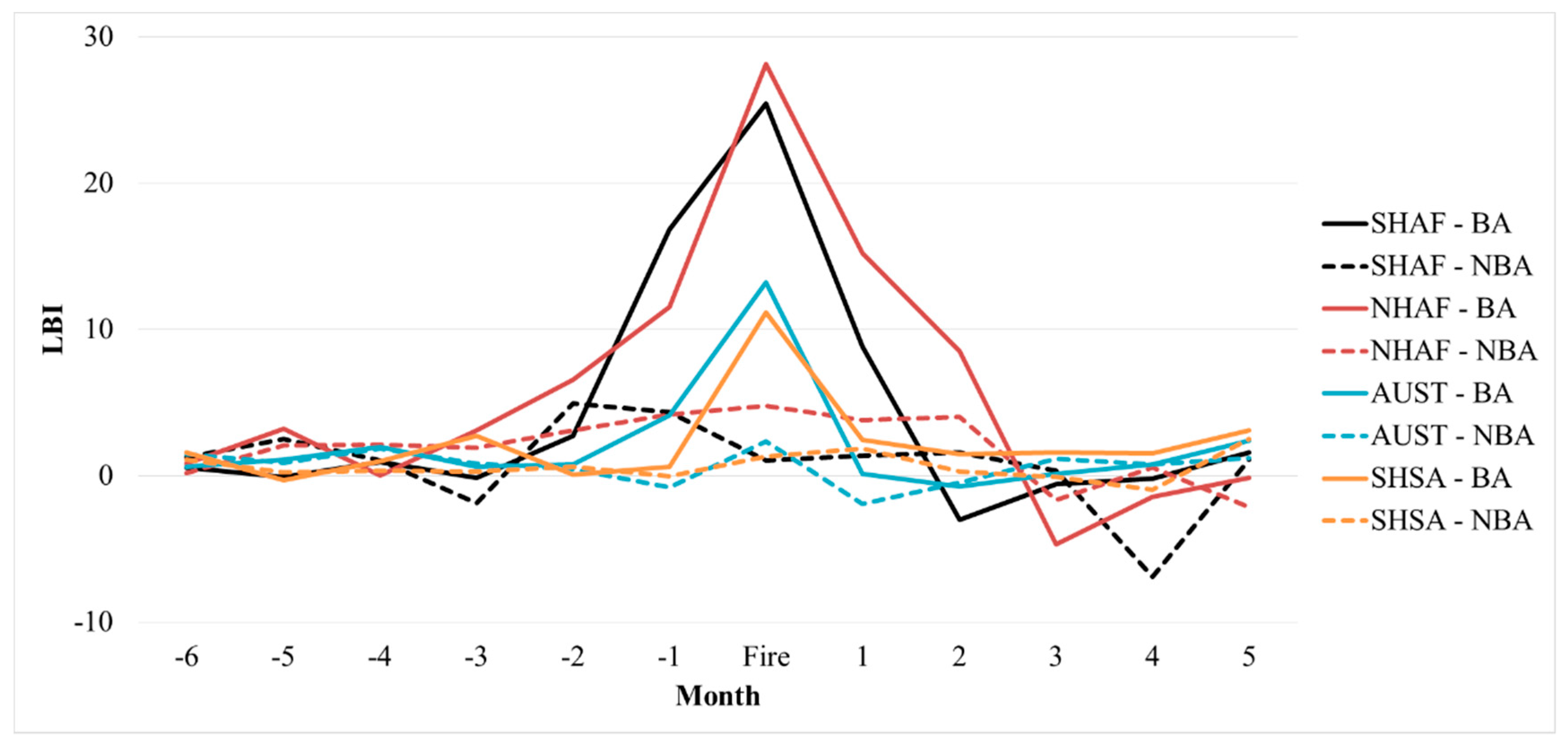
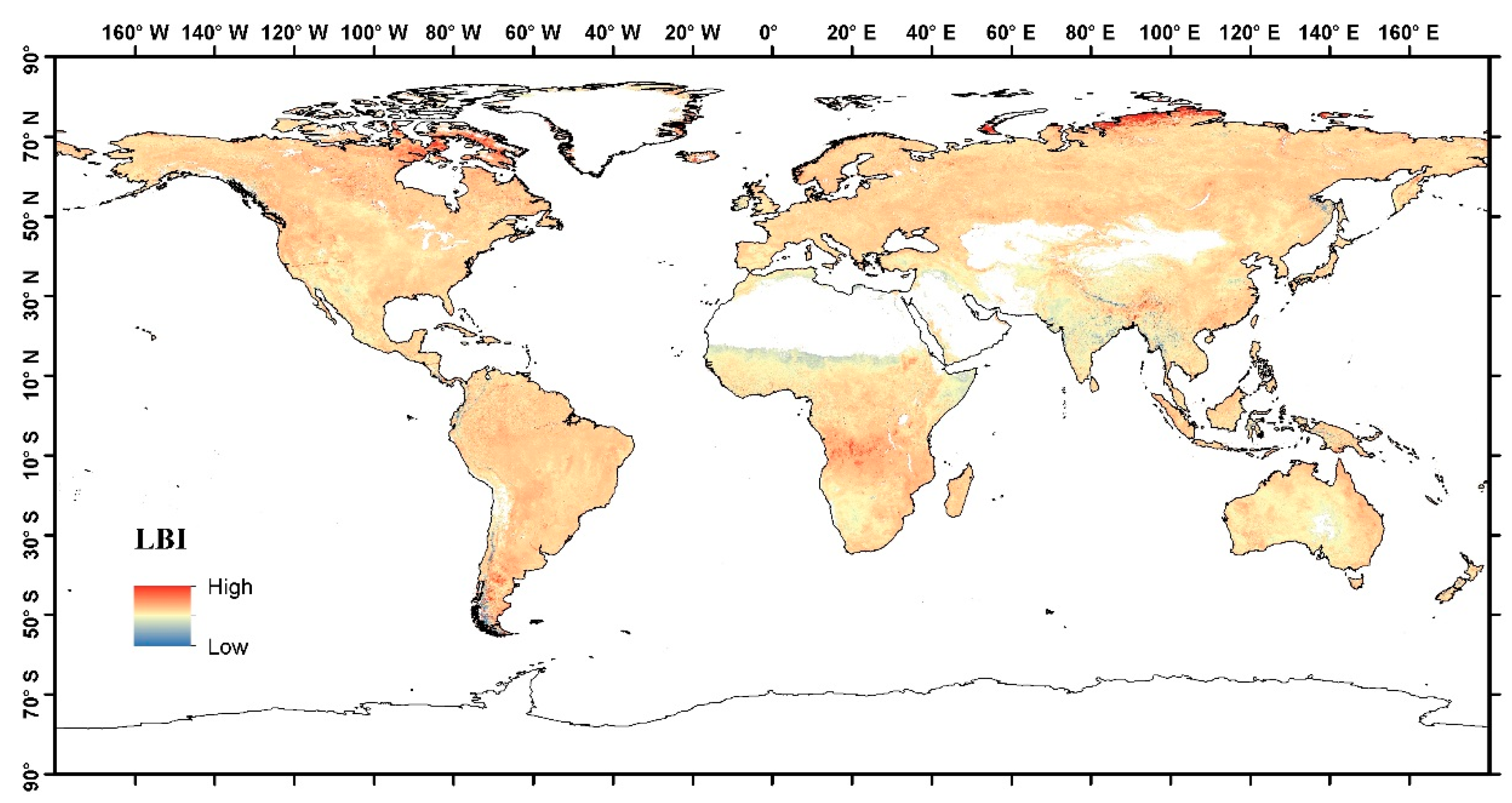
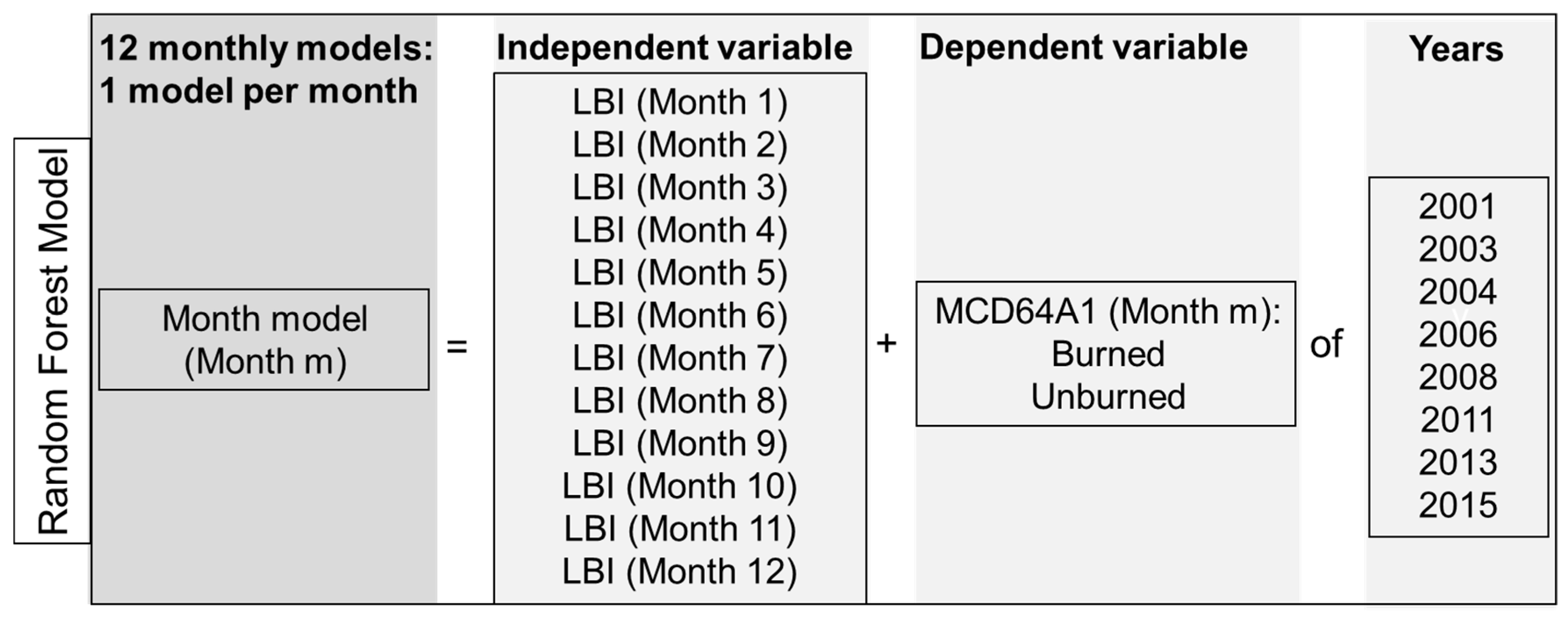
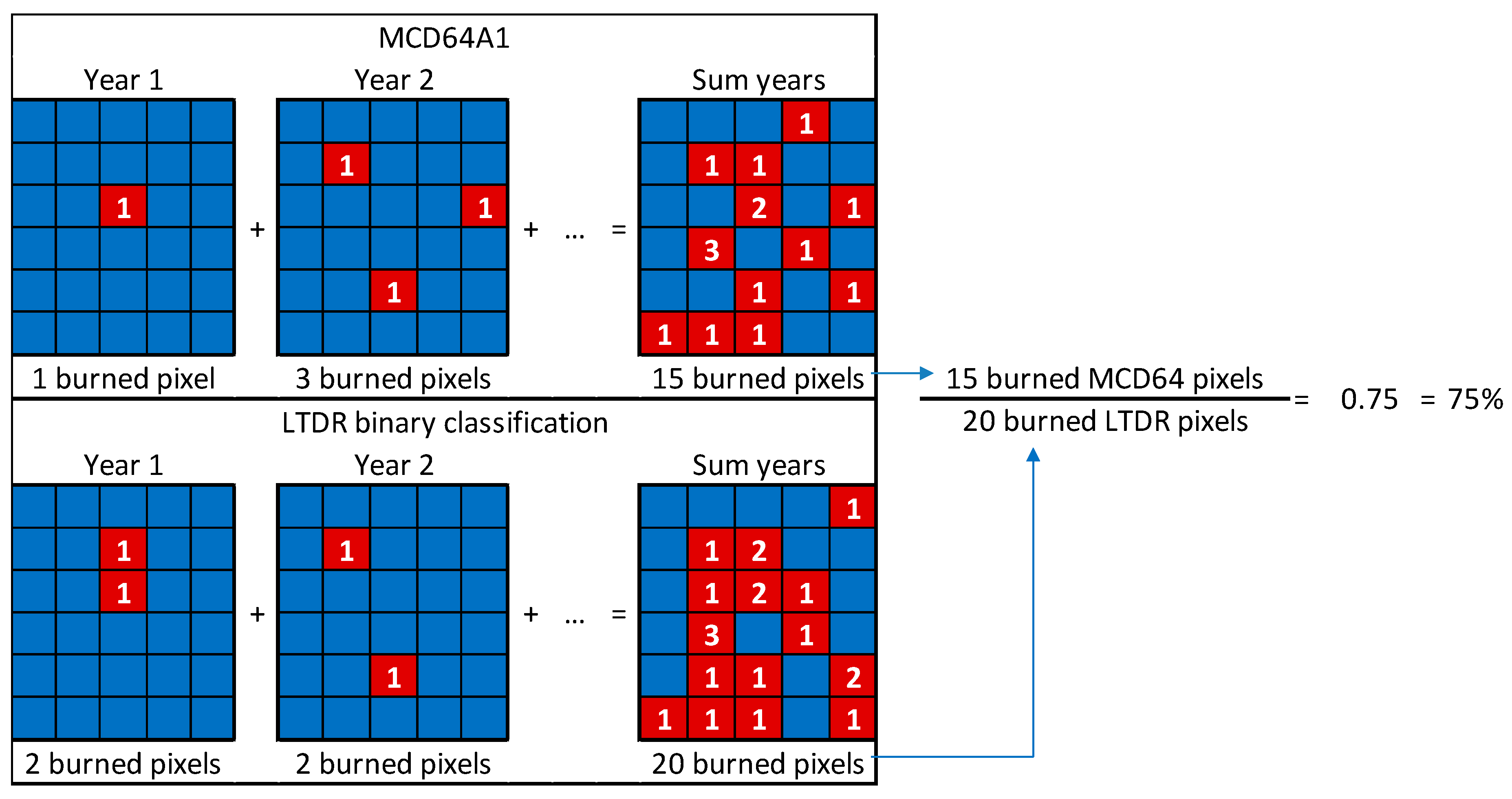
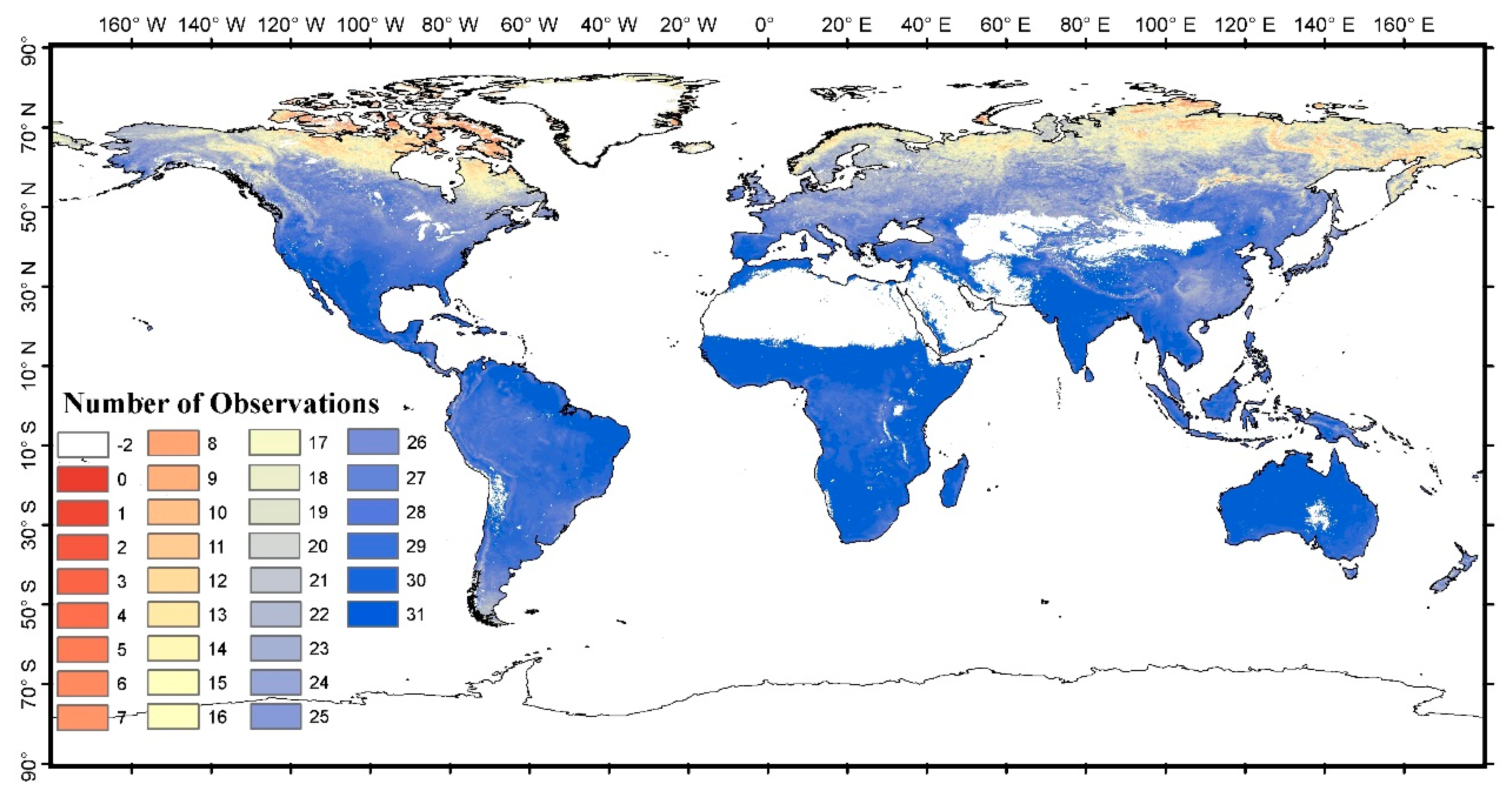
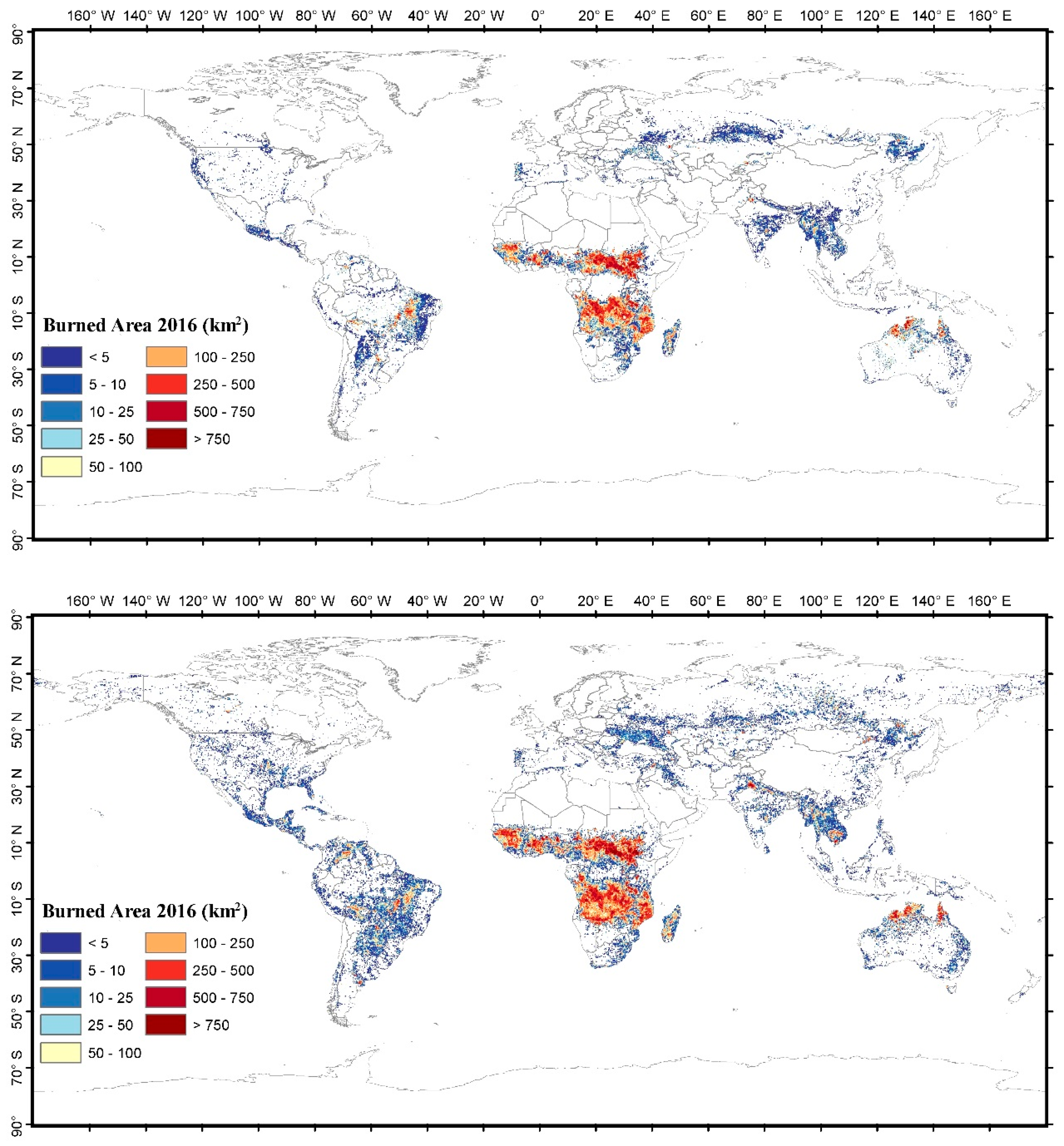

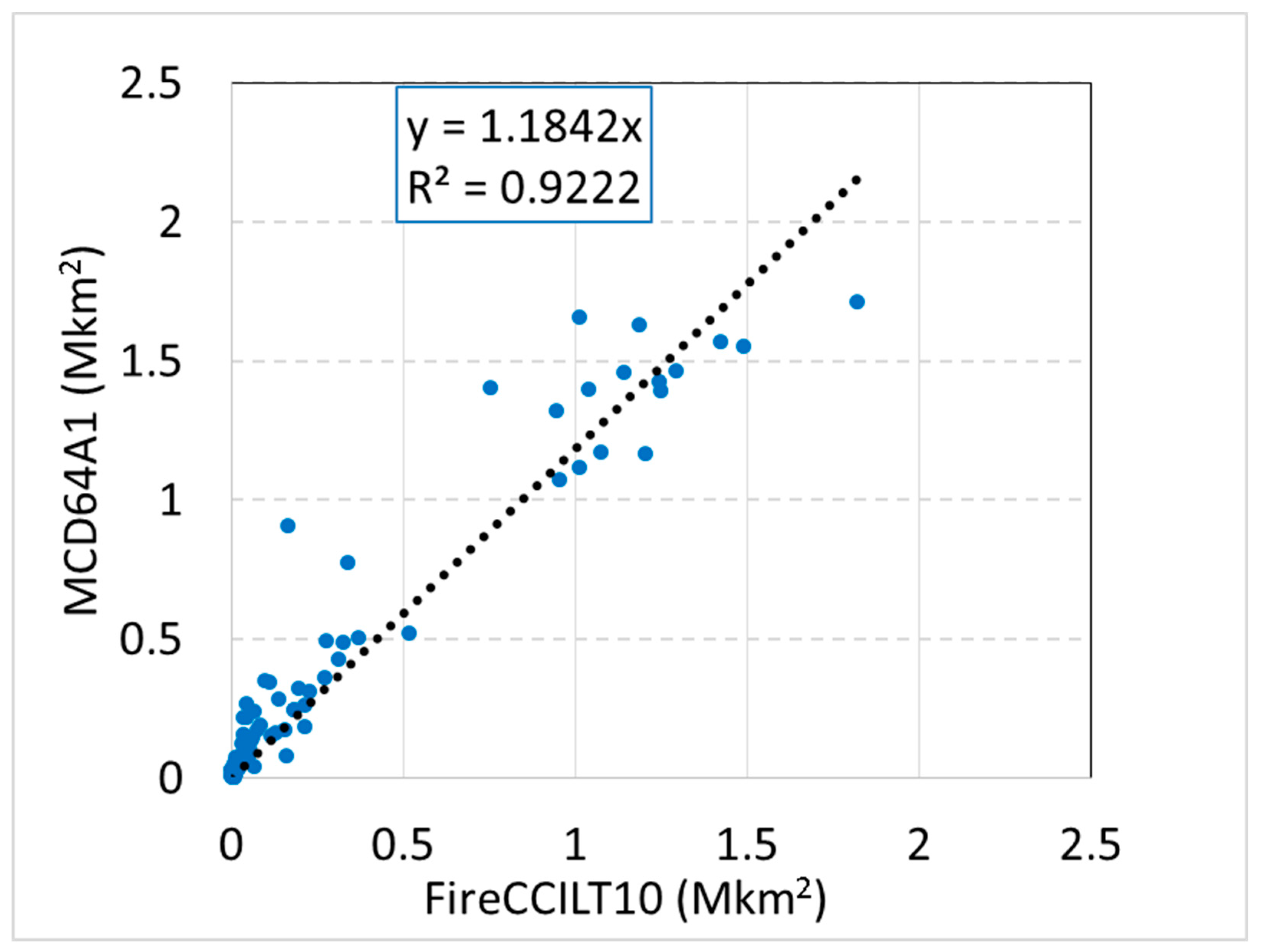
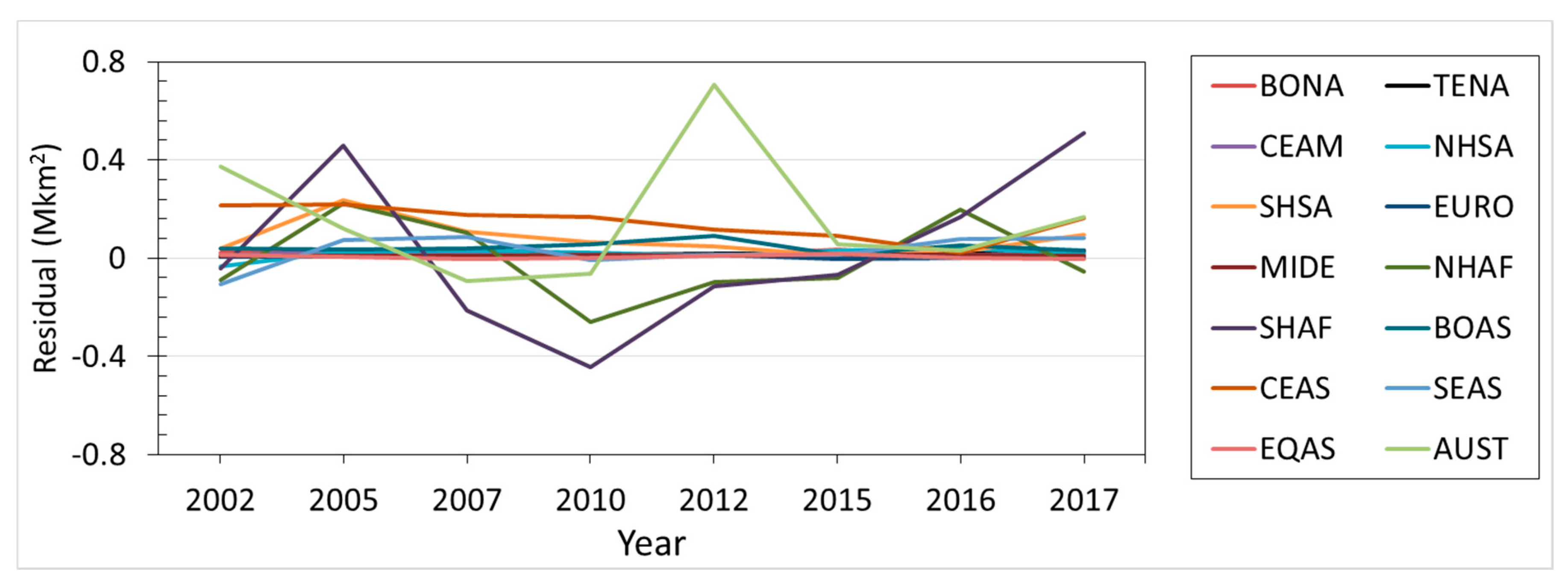
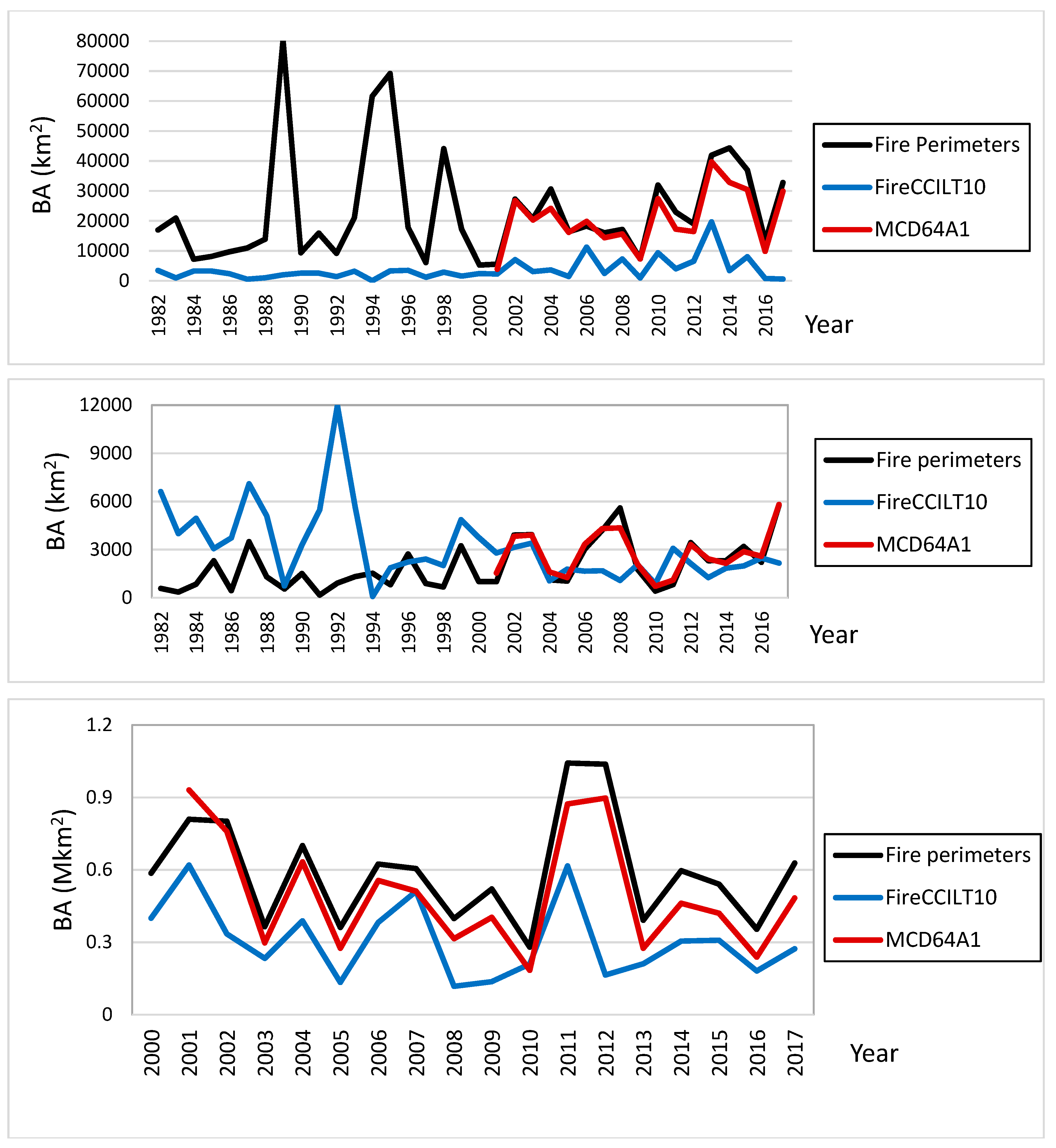
| Index | Formula | Developer | BA Application |
|---|---|---|---|
| Normalized Difference Vegetation Index | ρNIR = surface reflectance for channel 2 (0.725–1.1 µm) ρRED = surface reflectance for channel 1 (0.58–0.68 µm) | [35] | [11,36] |
| Global Environmental Monitoring Index | [37] | [18,21] | |
| Burned Area Index | Where ρcNIR and ρcRED are the convergence values for burned vegetation (defined for AVHRR as 0.06 and 0.1, respectively). | [38] | [18] |
| Soil Adjusted Vegetation Index | Being L soil reflectance (in this case L = 0.5) | [39] | [40] |
| Modified Soil Adjusted Vegetation Index | [41] | [21] | |
| Surface Temperature | T4 = TOA brightness temperature of channel 4 (~10.3–11.3 μm) T5 = TOA brightness temperature of channel 5 (~11.5–12.5 μm) | [42] | [21] |
| Continental Region | BONA | TENA | CEAM | NHSA | SHSA | EURO | MIDE |
| MCD64A1 (Mkm2) | 0.428 | 0.478 | 0.468 | 0.894 | 5.002 | 0.186 | 0.239 |
| FireCCILT10 (Mkm2) | 0.093 | 0.187 | 0.201 | 0.463 | 3.519 | 0.102 | 0.050 |
| Continental Region | NHAF | SHAF | BOAS | CEAS | SEAS | EQAS | AUST |
| MCD64A1 (Mkm2) | 21.917 | 25.927 | 1.586 | 3.417 | 2.358 | 0.260 | 8.702 |
| FireCCILT10 (Mkm2) | 20.348 | 22.984 | 0.745 | 1.378 | 1.948 | 0.100 | 5.204 |
© 2019 by the authors. Licensee MDPI, Basel, Switzerland. This article is an open access article distributed under the terms and conditions of the Creative Commons Attribution (CC BY) license (http://creativecommons.org/licenses/by/4.0/).
Share and Cite
Otón, G.; Ramo, R.; Lizundia-Loiola, J.; Chuvieco, E. Global Detection of Long-Term (1982–2017) Burned Area with AVHRR-LTDR Data. Remote Sens. 2019, 11, 2079. https://doi.org/10.3390/rs11182079
Otón G, Ramo R, Lizundia-Loiola J, Chuvieco E. Global Detection of Long-Term (1982–2017) Burned Area with AVHRR-LTDR Data. Remote Sensing. 2019; 11(18):2079. https://doi.org/10.3390/rs11182079
Chicago/Turabian StyleOtón, Gonzalo, Rubén Ramo, Joshua Lizundia-Loiola, and Emilio Chuvieco. 2019. "Global Detection of Long-Term (1982–2017) Burned Area with AVHRR-LTDR Data" Remote Sensing 11, no. 18: 2079. https://doi.org/10.3390/rs11182079
APA StyleOtón, G., Ramo, R., Lizundia-Loiola, J., & Chuvieco, E. (2019). Global Detection of Long-Term (1982–2017) Burned Area with AVHRR-LTDR Data. Remote Sensing, 11(18), 2079. https://doi.org/10.3390/rs11182079





